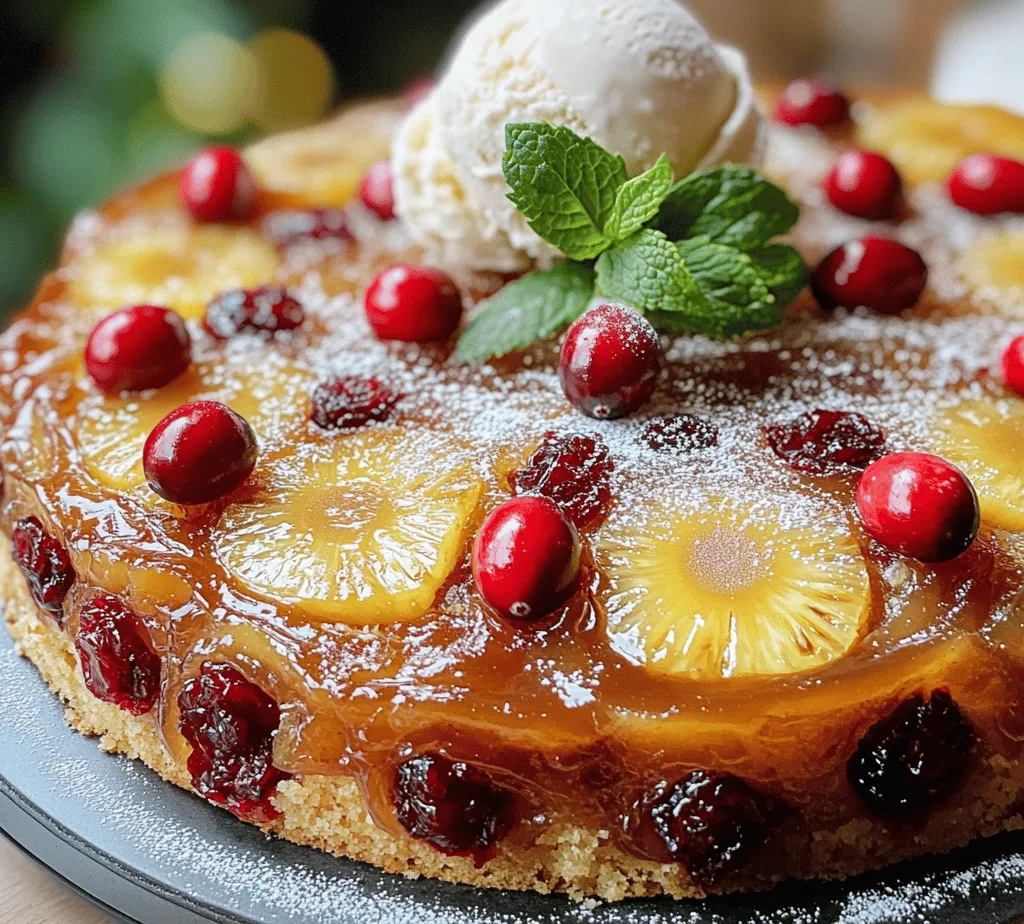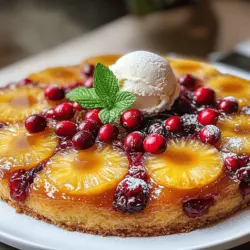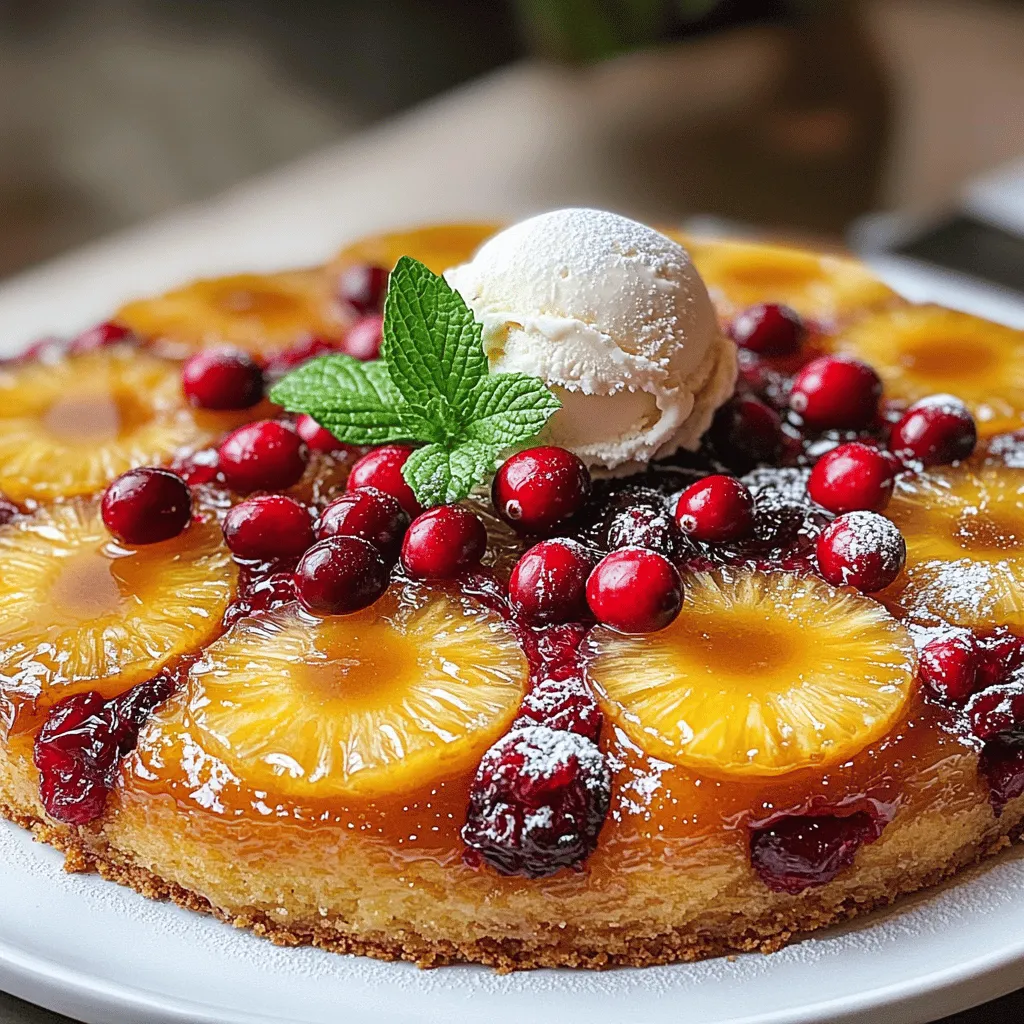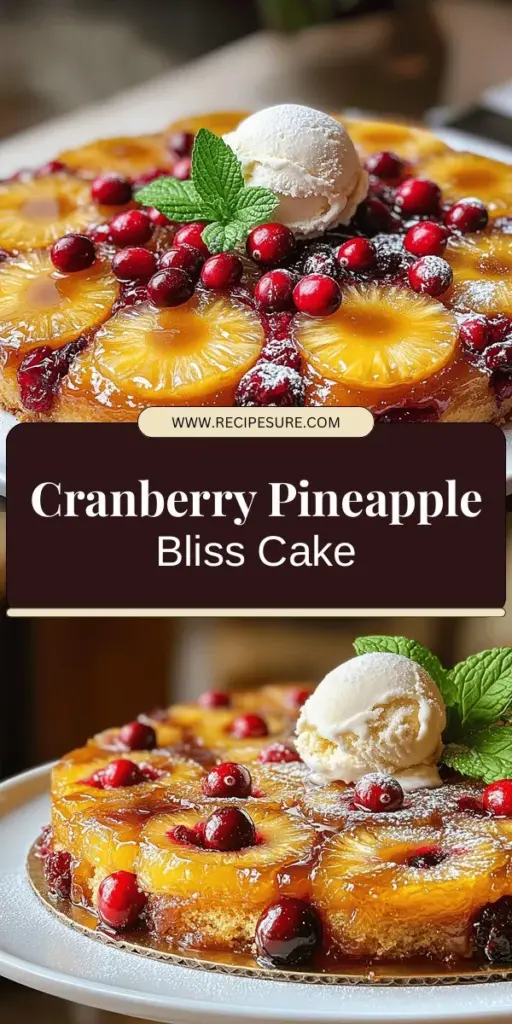When it comes to desserts that bring joy and delight to any occasion, few can compete with the allure of an upside-down cake. The Cranberry Pineapple Upside-Down Delight takes this beloved classic and elevates it with a vibrant combination of sweet pineapple and tart cranberries. This cake is not just a feast for the eyes with its stunning presentation but also a harmonious blend of flavors that dance on the palate. The tangy cranberries paired with the juicy sweetness of pineapple create a perfect balance, making it an irresistible treat for gatherings, holidays, or simply as a comforting dessert at home.
This unique twist on the traditional upside-down cake offers versatility that appeals to a wide audience. Whether you’re hosting a festive dinner, celebrating a birthday, or just wanting to indulge your sweet tooth, the Cranberry Pineapple Upside-Down Delight is sure to impress. With a moist, fluffy cake base topped with a luscious fruit layer, this recipe ensures that each slice is bursting with flavor. As we explore the preparation process, you can expect a delightful texture that combines the soft crumb of the cake with the gooey, caramelized fruit topping. Get ready to elevate your dessert game with this scrumptious creation!
Understanding the Ingredients
Before diving into the preparation of the Cranberry Pineapple Upside-Down Delight, it’s essential to understand the key ingredients that contribute to its enchanting flavor profile and texture. Each component plays a significant role in creating the perfect balance of sweetness and tartness while ensuring a moist and fluffy cake.
The Topping
The topping is where the magic begins, transforming a simple cake into a stunning visual and flavorful masterpiece. Here are the essential ingredients that make up the delicious fruit topping.
Fresh vs. Frozen Cranberries
Cranberries are the star of the show in this recipe, providing a burst of tartness that complements the sweetness of the pineapple. When choosing cranberries, you have the option of using fresh or frozen. Fresh cranberries are typically available in the fall and early winter months, boasting a bright, tangy flavor and a firm texture that holds up beautifully in baking. On the other hand, frozen cranberries offer convenience and are available year-round. They are also harvested and frozen at peak ripeness, ensuring a flavorful experience. However, frozen cranberries may release more moisture during baking, which can slightly alter the texture of the cake.
Pineapple Rings
Pineapple rings are another essential ingredient in this delightful dessert. When it comes to choosing your pineapple, you can opt for either fresh or canned. Fresh pineapple offers an unmatched sweetness and juiciness, along with a vibrant flavor that shines through in the cake. However, if convenience is key, canned pineapple rings are a fantastic alternative. They are typically packed in juice or syrup, making them sweeter and ensuring they maintain moisture. Just be sure to drain them well to prevent excess liquid from affecting the cake’s texture.
Brown Sugar
Brown sugar is crucial in creating the rich caramel topping that coats the cranberries and pineapple. Its molasses content not only adds depth of flavor but also contributes to the beautiful caramelization during baking. This results in a luscious, gooey layer that enhances the overall taste of the cake. For an even more complex flavor, you can use dark brown sugar, which has a higher molasses content and offers a deeper, richer taste.
Unsalted Butter
Butter plays a vital role in both flavor and moisture. Using unsalted butter allows for better control over the overall saltiness of the cake. As it melts during baking, it creates a tender crumb and brings out the flavors of the other ingredients. Be sure to use room-temperature butter for easy incorporation into the batter, leading to a light and fluffy texture.
The Cake
Now that we’ve covered the topping, let’s explore the ingredients that form the cake base. Each element contributes to the cake’s structure, flavor, and overall appeal.
All-Purpose Flour
All-purpose flour is the backbone of the cake, providing structure without being overly dense. Its versatility makes it a staple in many baking recipes. For this upside-down delight, the flour must be properly measured and sifted to avoid lumps and ensure an even texture.
Granulated Sugar
Granulated sugar is responsible for sweetness and plays a crucial role in the cake’s rise. When creamed with butter, sugar helps to incorporate air into the batter, resulting in a light and fluffy cake. The right amount of sugar is essential for achieving the perfect balance of sweetness in this dessert.
Eggs
Eggs serve as a binding agent in the cake, providing moisture and stability. They also help the cake rise and contribute to its overall texture. For optimal results, it’s best to use large eggs at room temperature, as they will incorporate more easily into the batter.
Milk
Milk is a key ingredient that enhances the cake’s moisture and contributes to its tender crumb. It also helps to create a smooth batter. Whole milk is recommended for this recipe, as its fat content adds richness and flavor. If you prefer a lighter option, you can use low-fat milk or a non-dairy alternative.
Vanilla Extract
Vanilla extract is the secret ingredient that elevates the cake’s flavor profile. It adds a warm, aromatic sweetness that complements the fruit topping. Using pure vanilla extract is recommended for the best flavor, although imitation vanilla can be used in a pinch.
Baking Powder
Baking powder is the leavening agent that helps the cake rise, creating a light and airy texture. It’s essential to ensure that your baking powder is fresh, as expired leavening agents can lead to dense, flat cakes.
Ground Cinnamon
Ground cinnamon adds a warm and comforting spice to the cake, enhancing its overall flavor. This aromatic spice pairs beautifully with the sweetness of the pineapple and the tartness of the cranberries. A pinch of cinnamon can elevate the flavor profile without overwhelming the other ingredients.
Step-by-Step Recipe Instructions
Now that you’re familiar with the ingredients, let’s get ready to bring this delightful dessert to life. The first step in creating the Cranberry Pineapple Upside-Down Delight is preparing the topping, which sets the stage for the entire cake.
Preparing the Topping
Before anything else, it’s vital to preheat your oven to 350°F (175°C). Preheating is an essential step in baking, as it ensures that the cake begins cooking at the right temperature, allowing for even rise and consistent baking. If the oven is not properly heated, the cake may not rise correctly, potentially leading to a dense texture.
While the oven is preheating, you can start preparing the caramel topping. In a medium saucepan over low heat, melt the unsalted butter and brown sugar together until they form a smooth caramel. Once melted, remove the saucepan from the heat and add the cranberries and pineapple rings, stirring gently to coat the fruit evenly in the caramel mixture.
Next, you’ll need to prepare your baking pan. A 9-inch round cake pan is recommended for this recipe. Grease the pan with cooking spray or additional butter to prevent sticking, then pour the caramel-coated fruit mixture into the bottom of the pan, spreading it out evenly. This layer will create the stunning top of the cake once it’s flipped over after baking.
Once the topping is ready and the oven is preheated, you can move on to preparing the cake batter, ensuring that all the delicious flavors come together beautifully.
Stay tuned for the next part of our article, where we’ll guide you through the detailed steps for creating the cake batter and baking this delightful dessert to perfection.

Melting Butter: Techniques for Even Melting
When it comes to baking, the way you melt your butter can significantly impact your final product. For our Cranberry Pineapple Upside-Down Delight, even melting is crucial for achieving a smooth and consistent batter. Here are a few effective techniques:
1. Microwave Method: Cut your butter into small cubes and place it in a microwave-safe bowl. Microwave in short intervals of 15-20 seconds, stirring in between each interval until fully melted. This method is quick and efficient, ensuring the butter melts evenly without burning.
2. Stovetop Method: Place the butter in a small saucepan over low heat. Stir constantly until melted, ensuring it doesn’t reach a boiling point, which can alter its properties and affect the texture of your cake.
3. Room Temperature Method: If you prefer not to melt your butter, you can simply leave it out at room temperature for about an hour before you start baking. This will soften the butter and make it easier to cream with sugar, contributing to a light and fluffy texture.
Creating the Brown Sugar Mixture: Tips for Achieving the Right Consistency
The brown sugar mixture is the heart of our upside-down cake, providing that signature caramel flavor that beautifully complements the tart cranberries and sweet pineapple. Here’s how to create the perfect mixture:
1. Choosing Your Sugar: Use packed brown sugar for a richer taste. The moisture in brown sugar is key to creating that gooey, caramel-like texture.
2. Adding Butter: Combine the melted butter with the brown sugar in a bowl. Mix thoroughly until you achieve a smooth consistency. The right texture should be thick enough to coat the back of a spoon without being overly runny.
3. Incorporating Flavor: For added depth, consider stirring in a pinch of salt or a splash of vanilla extract into the mixture. This enhances the flavor profile and balances the sweetness with a touch of savory.
Arranging Fruits: Aesthetic Presentation and Flavor Distribution
The fruit arrangement is not only about looks; it’s also about flavor. Here’s how to create an eye-catching and delicious topping:
1. Slicing Pineapple: If you’re using fresh pineapple, slice it into rings about half an inch thick. If using canned pineapple, ensure to drain it well to avoid excess moisture.
2. Layering Fruits: Start by pouring the brown sugar mixture into the bottom of your prepared pan. Arrange the pineapple rings evenly, ensuring they slightly overlap for a beautiful presentation. Then, scatter cranberries around the pineapple, filling in any gaps. This not only looks appealing but ensures that every slice has a balance of fruit.
3. Consider Color and Texture: Mixing different shades of cranberries and the bright, golden pineapple creates a vibrant look. Aim for a mix of whole and halved cranberries to add variety in both presentation and taste.
Making the Cake Batter
Now that your fruit base is ready, it’s time to make the cake batter that will sit atop this gorgeous arrangement.
Creaming Butter and Sugar: The Importance of This Step
Creaming butter and sugar is a fundamental technique in baking. This step is crucial for incorporating air into the batter, which helps your cake rise and achieve that light, fluffy texture.
1. Use Room Temperature Ingredients: Ensure your butter is soft enough to easily blend with sugar. This can take about an hour out of the fridge.
2. Mixing Time: Using a stand mixer or handheld mixer, beat the butter and sugar together on medium speed for about 3-5 minutes. You want to achieve a pale, fluffy mixture that has increased in volume.
3. Scrape the Bowl: Don’t forget to scrape down the sides of the bowl occasionally. This ensures that all ingredients are combined evenly and that no sugary lumps remain.
Incorporating Eggs: Tips for Achieving a Smooth Batter
Once your butter and sugar are creamed, it’s time to add the eggs, which contribute moisture and structure.
1. One at a Time: Add the eggs one at a time, mixing well after each addition. This allows for better emulsification and prevents the batter from separating.
2. Room Temperature Eggs: Just like the butter, eggs should also be at room temperature. This helps them incorporate more easily into the batter, preventing a lumpy texture.
3. Mix Until Just Combined: After adding the eggs, mix until just combined. Overmixing can lead to a dense cake, so stop as soon as you no longer see streaks of egg.
Mixing Dry and Wet Ingredients: The Importance of Not Overmixing for Texture
When combining your dry and wet ingredients, it’s crucial to maintain the right texture.
1. Sifting Dry Ingredients: In a separate bowl, sift together your flour, baking powder, and any spices. Sifting aerates the flour, which helps prevent clumps and incorporates air.
2. Alternating Method: Gradually add the dry ingredients to the wet mixture, alternating with milk or other liquids. Start and finish with the dry ingredients, mixing until just combined. This helps maintain the cake’s lightness.
3. Folding Technique: If you see any streaks of flour, use a spatula to gently fold the batter, being careful not to overmix. The goal is to combine everything without losing that precious air you worked so hard to incorporate.
Combining and Baking
With your batter ready, it’s time to combine everything and bake.
Pouring the Batter: Techniques for Even Distribution
Even distribution of the batter is essential for a uniform rise and cooking.
1. Gently Pour: Start by gently pouring the batter over the arranged fruits. Use a spatula to help spread the batter evenly to the edges of the pan.
2. Tap the Pan: After pouring, tap the pan on the counter gently. This helps eliminate any air bubbles that may cause uneven baking.
Baking Time: Signs of Doneness and What to Look For
Baking time can vary, but there are clear signs that your cake is done.
1. Visual Cues: Look for a golden-brown top that springs back when lightly pressed. The edges should pull away slightly from the sides of the pan.
2. Toothpick Test: Insert a toothpick into the center of the cake. If it comes out clean or with a few moist crumbs (but no wet batter), your cake is done.
3. Cooling Time: Let the cake cool in the pan for about 10-15 minutes before inverting it onto a serving plate. This allows the sugar mixture to set slightly, making for easier removal.
Cooling Process: Importance of Letting the Cake Rest
Allowing your cake to cool is a crucial step that shouldn’t be rushed.
1. Settle the Flavors: Resting allows the flavors to meld together, enhancing the overall taste of the cake.
2. Preventing Cracks: If you attempt to slice the cake too soon, it may crack or break apart. Letting it cool in the pan helps it firm up and hold its shape better.
Serving Suggestions
Now that your Cranberry Pineapple Upside-Down Delight is baked and cooled, it’s time to explore serving options that will impress your guests.
Presentation Ideas
Creating a visually appealing presentation can enhance the overall experience of your dessert.
1. Plate Presentation: Serve individual slices on white plates to highlight the vibrant colors of the pineapple and cranberries. Consider using a large, round platter for a family-style presentation.
2. Garnishes: Add a dollop of whipped cream or a scoop of vanilla ice cream on the side. Fresh mint leaves can brighten up the plate and add a pop of color, making the dessert even more inviting.
Pairing Options
To elevate your dessert experience, consider pairing your cake with complementary beverages.
1. Beverage Pairings: A light herbal tea or a cup of freshly brewed coffee pairs wonderfully with the fruity flavors of the cake. For something more festive, a sparkling wine or a light white wine can enhance the sweetness and acidity of the cranberries and pineapple.
Nutritional Information
Understanding the nutritional aspects can help you enjoy this dessert mindfully.
1. Calories: A serving of Cranberry Pineapple Upside-Down Delight typically contains around 250-300 calories, depending on portion size and ingredients used.
2. Fats and Sugars: Expect to find approximately 10-15 grams of fat and 20-25 grams of sugar per serving. The use of brown sugar and butter contributes to these totals.
3. Dietary Considerations: This cake is not gluten-free or dairy-free, but substitutions can be made for those with dietary restrictions, such as using gluten-free flour or plant-based butter.
Conclusion
The Cranberry Pineapple Upside-Down Delight is more than just a dessert; it’s a celebration of flavor, texture, and visual appeal. Its unique combination of tart cranberries and sweet pineapple creates a delightful contrast that can bring joy to any gathering.
As you embark on this baking adventure, remember that the process is as enjoyable as the outcome. Embrace the techniques, and don’t hesitate to experiment with your own twists to make this recipe your own. Whether you’re serving it for a special occasion or simply to brighten your day, this cake is sure to impress and satisfy. Enjoy the delightful experience of baking and savor each slice of this charming treat!


